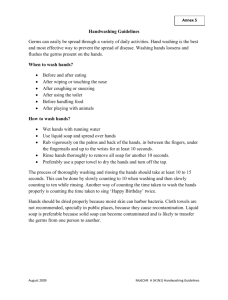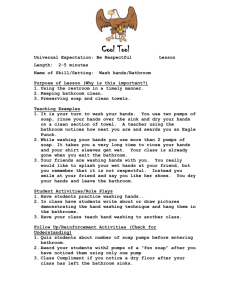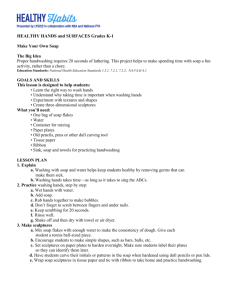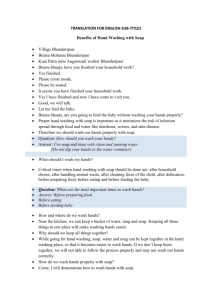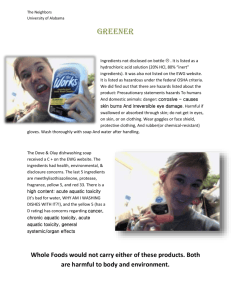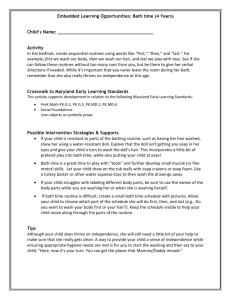Effectiveness of Hand Washing
advertisement
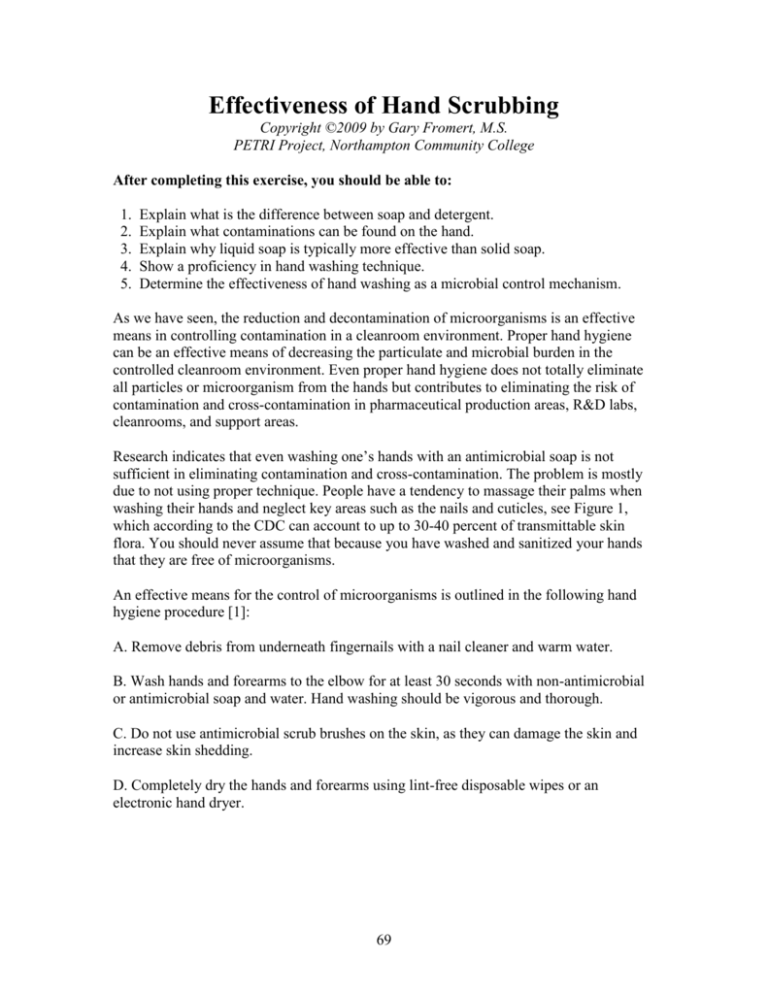
Effectiveness of Hand Scrubbing Copyright ©2009 by Gary Fromert, M.S. PETRI Project, Northampton Community College After completing this exercise, you should be able to: 1. 2. 3. 4. 5. Explain what is the difference between soap and detergent. Explain what contaminations can be found on the hand. Explain why liquid soap is typically more effective than solid soap. Show a proficiency in hand washing technique. Determine the effectiveness of hand washing as a microbial control mechanism. As we have seen, the reduction and decontamination of microorganisms is an effective means in controlling contamination in a cleanroom environment. Proper hand hygiene can be an effective means of decreasing the particulate and microbial burden in the controlled cleanroom environment. Even proper hand hygiene does not totally eliminate all particles or microorganism from the hands but contributes to eliminating the risk of contamination and cross-contamination in pharmaceutical production areas, R&D labs, cleanrooms, and support areas. Research indicates that even washing one’s hands with an antimicrobial soap is not sufficient in eliminating contamination and cross-contamination. The problem is mostly due to not using proper technique. People have a tendency to massage their palms when washing their hands and neglect key areas such as the nails and cuticles, see Figure 1, which according to the CDC can account to up to 30-40 percent of transmittable skin flora. You should never assume that because you have washed and sanitized your hands that they are free of microorganisms. An effective means for the control of microorganisms is outlined in the following hand hygiene procedure [1]: A. Remove debris from underneath fingernails with a nail cleaner and warm water. B. Wash hands and forearms to the elbow for at least 30 seconds with non-antimicrobial or antimicrobial soap and water. Hand washing should be vigorous and thorough. C. Do not use antimicrobial scrub brushes on the skin, as they can damage the skin and increase skin shedding. D. Completely dry the hands and forearms using lint-free disposable wipes or an electronic hand dryer. 69 Figure 1. Areas most often missed during hand washing. (www.cemag.us/articles.asp) The application of water alone is inefficient for cleaning skin because water is often unable to remove fats, oils, and proteins, which are components of organic buildup or to remove microbial contamination. Therefore, removal of organic buildup and microorganisms from skin requires the addition of soaps or detergents to water. Currently most products sold as "soaps" are actually detergents, which is a cleansing substance that acts similarly to soap but is made from chemical compounds rather than fats and lye. Other factors like water temperature also affect hand hygiene. Hot water that is comfortable for washing hands is not hot enough to kill bacteria. However, warm, soapy water is more effective than cold, soapy water is most effective at removing the natural oils on your hands which hold contaminants and microorganisms. Also, liquid soap is more effective than solid soap because of solid soaps reusable nature, it may hold microorganisms acquired from previous uses. In this laboratory exercise two students as a group will be performing a hand washing procedure. One student will follow a "Water Only" washing protocol and the other student will be following a "Soap and Water Rinse" protocol. Fingers from a designated experimental hand will be sampled for bacteria prior to and after each washing step. The percent change for each protocol will be calculated and compared to determine the effectiveness of the hand washing protocols. 70 Materials (per group of 2 students) 2 TSA or Nutrient Agar Plates Liquid Hand Soap (preferably non-antimicrobial) Timer China Marker or Sharpie Note: Two students will work together to perform the hand washing exercise. Procedure 1 Hand Washing Effectiveness 1. One student, divide one nutrient agar plate into three sections by marking the bottom of the plate. Label the sections "A ", "B", and "C". Label the plate "Water Only", include your initials and the date. The other student, divide the other nutrient agar plate into three sections by marking the bottom of the plate. Label the sections "A ", "B", and "C". Label the plate "Soap & Water", include your initials and the date. 2. At this point in the experiment you will need to designate a hand for lifting the top from the plate and a hand that you will designate as the experimental hand, you must carry this hand designation throughout the rest of the experiment. 3. The student with the "Water Only" plate. Using your designated hand, remove the top of the plate, exposing the media surface, press your index and middle fingers from your experimental hand gently but firmly simultaneously to the surface of the media marked "A". Remove your fingers and replace the top of the plate. Wash your experimental hand well with warm water only for 15 seconds vigorously and thoroughly, rinse with warm water for 30 seconds, shake off excess water, and, while still wet, touch section "B" with your index and middle fingers from your experimental hand. Note: Do not dry your fingers. Wash again, and while wet touch section "C". 4. The student with the "Soap & Water" plate. Using your designated hand, remove the top of the plate, exposing the media surface, press your index and middle fingers from your experimental hand gently but firmly simultaneously to the surface of the media marked "A". Remove your fingers and replace the top of the plate. Wash your experimental hand well with soap for 15 seconds vigorously and thoroughly, rinse with warm water for 30 seconds, shake off excess water, and, while still wet, touch section "B" with your index and middle fingers from your experimental hand. Note: Do not dry your fingers. Wash again with soap and rinse with warm water, and while wet touch section "C". 5. Incubate the two nutrient agar plates at 37°C for 24 to 48 hours. 6. Observe the plates for growth of viable microorganisms on the media surface and record your results. 71 Results and Observations After examining your plates, record your results in the following table. For all plates, semi-quantify your results as follows: “4” = maximum growth, “3” = moderate growth, “2” = some growth, “1” = a little growth, and “0” = no growth. Section Student Water Only Student Soap and Water Rinse A - Control B - First Wash C - Second Wash Calculate the percent change compared to the control using the following equation and record in the table below: test score – control score % change = _____________________ × 100 control score Wash % Change Water Only % Change Soap and Water First Second Laboratory Review 1. Explain what is difference between soap and detergent: ________________________________________________________________________ ________________________________________________________________________ ________________________________________________________________________ 72 ________________________________________________________________________ ________________________________________________________________________ __________________________________________________________________ 2. Explain what contaminations can be found on the hand: ________________________________________________________________________ ________________________________________________________________________ ________________________________________________________________________ ________________________________________________________________________ ___________________________________________________________________ 3. Explain why liquid soap is typically more effective than solid soap: ________________________________________________________________________ ________________________________________________________________________ ________________________________________________________________________ ________________________________________________________________________ ___________________________________________________________________ 4. Discuss the relative difference in hand washing efficiency between the two hand washing protocols preformed in this laboratory exercise: ________________________________________________________________________ ________________________________________________________________________ ________________________________________________________________________ ________________________________________________________________________ ________________________________________________________________________ ________________________________________________________________________ ________________________________________________________________________ ________________________________________________________________ References [1] U.S. Pharmacopeia 27NF22, Chapter < 797> Pharmaceutical Compounding—Sterile Preparations. Rockville, MD 2008 73
